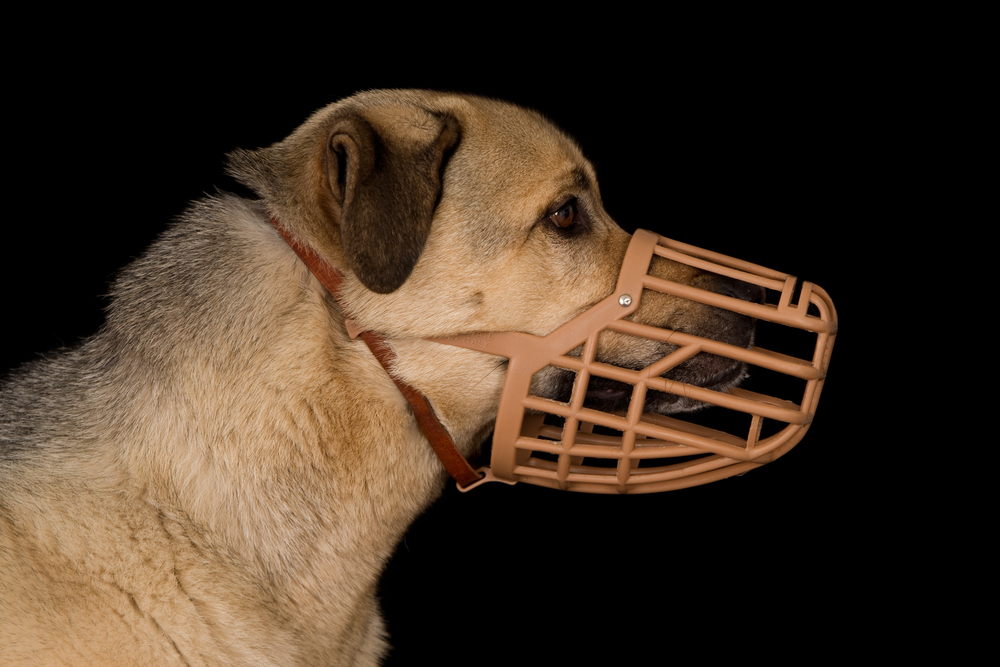Just like people, dogs want to feel safe and happy. The emotionally protective practices employed through Fear Free help to keep animals calm and comfortable throughout care and prevent them from feeling a need to escalate to a bite. But as much as we plan and try to protect our precious pooches, the truth is that dogs are unpredictable and may respond defensively if they feel afraid, threatened, or in pain. A muzzle can help with that, but only if the dog is already used to and comfortable in one.
Teaching a dog to willingly wear a muzzle is comparable to purchasing car insurance. While we hope it’s never needed, in the event that an incident occurs, it’s a lifeline that minimizes damage and protects all parties involved—two-legged and four-legged. And feel-good food rewards while wearing the muzzle promote pleasant associations with care. The following tips and tricks help to build comfort and calm in dogs as they become accustomed to being fitted for and wearing a muzzle.
Choosing a Muzzle
The right type of muzzle allows the dog to still enjoy tasty treat rewards as he’s being cared for. Look for a hard-sided basket muzzle with holes and slats on the front and sides. This allows you to easily offer the dog treats such as lickable cheese or meat paste through the basket muzzle openings. Pairing these positives with care makes wearing a muzzle a win-win-win for your dog, yourself, and caregivers. A basket muzzle also allows dogs to pant which helps them dissipate heat and stress.
Getting Started
Give dogs the choice to approach and investigate the muzzle at their own pace. Allowing them to initiate the approach and choose the pace of the interaction builds confidence with the item, especially when you reward them for it.
Hold the muzzle in your hand or between your knees. This allows the dog to approach while the muzzle is kept still.
Smear a soft treat such as squeeze cheese or peanut butter on the outer edge of the muzzle leading to the front, inner portion of the muzzle where the dog’s nose and mouth will eventually go. Once the dog’s nose is inside, deliver small, soft treats that are easy to swallow with minimal chewing, pretzel sticks with more of the soft spread can be advanced toward the dog’s mouth through the slats or holes of the muzzle.
Over time, build the duration that your dog keeps her nose inside the muzzle. You can do this by continuing to reward your dog intermittently while the nose remains inside the muzzle. Leave the muzzle unstrapped so the dog can move away if she chooses.
Increase your dog’s eagerness to push and keep the nose inside by removing the muzzle just as the dog finishes the treat spread. Aim to reward the dog frequently but stop before he loses interest or becomes uncomfortable and chooses to move his nose out.
KISS: Keep It Short, Simple
Keep sessions short and treat frequency high to further hold your dog’s interest and keep her eagerly invested in the training process. When your dog shows happy anticipation and eager interest in placing the nose into the muzzle for longer periods, you can start to secure the muzzle. Do this by having the muzzle pre-strapped or buckled, but loose. Allow the dog to slip her own head into the muzzle as the strap is held up and then gently slipped over the top of the head.
Alternatively, work on buckling or strapping the muzzle while a helper feeds the dog. If you don’t have an assistant, secure food treats to the wall with a product such as a Slow Treater or hold a stuffed Kong between your knees. Secure muzzle straps as the dog eats.
Once the muzzle is in place, support the underside with your hand as you feed treats. This accustoms the dog gradually to the weight and feel of the muzzle when worn. Remove the muzzle after several seconds, before the point that the dog becomes concerned.
When the dog appears calmly relaxed when wearing the muzzle with straps placed, fit the muzzle to the dog’s face so it can be worn comfortably without slipping, sliding, or falling off. Keep the dog occupied with a treat toy or give treats quickly as you adjust the muzzle. You can also remove the muzzle to adjust it before again placing it on the dog.
Once the muzzle is properly fitted and your dog voluntarily places his nose inside as straps are secured, start introducing brief muzzle-wearing sessions. Focus your dog’s attention on activities they enjoy, such as performing a favorite trick, following you for hand-fed treats, or going on a walk.
Keep the muzzle’s value high by continuing to pair it with happy consequences. If the muzzle is used only during times of concern, such as handling or procedures, the dog may become wary of it. Instead, pair the muzzle with a variety of situations with happy outcomes such as an outing to a favorite place or a fun visit to a Fear Free veterinarian or groomer.
When properly trained to enjoy wearing a muzzle, a dog can arrive at places of care, such as the veterinarian or groomer, with the muzzle already in place. Doing so reduces the potential stress of the dog being placed in an unfamiliar muzzle by someone he doesn’t know.
For extra help, check out the muzzle training how-to video link here.
This article was reviewed/edited by board-certified veterinary behaviorist Dr. Kenneth Martin and/or veterinary technician specialist in behavior Debbie Martin, LVT.
Mikkel Becker is the lead animal trainer for Fear Free Pets. She is a certified behavior consultant and trainer who specializes in reward-based training that’s partnered closely with the pet’s veterinary team. Mikkel is the co-author of six books, including From Fearful to Fear Free.








